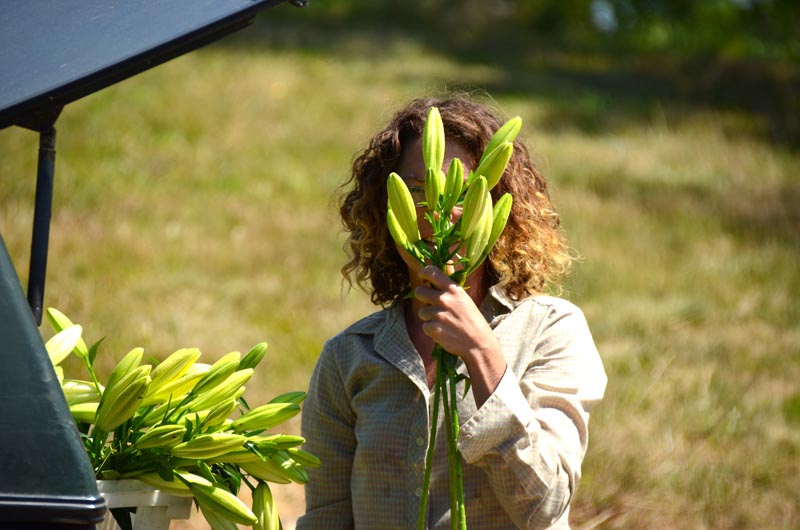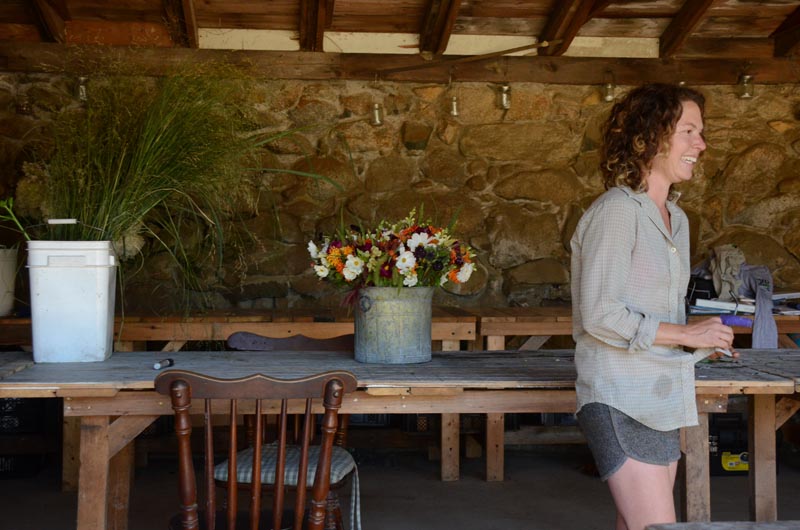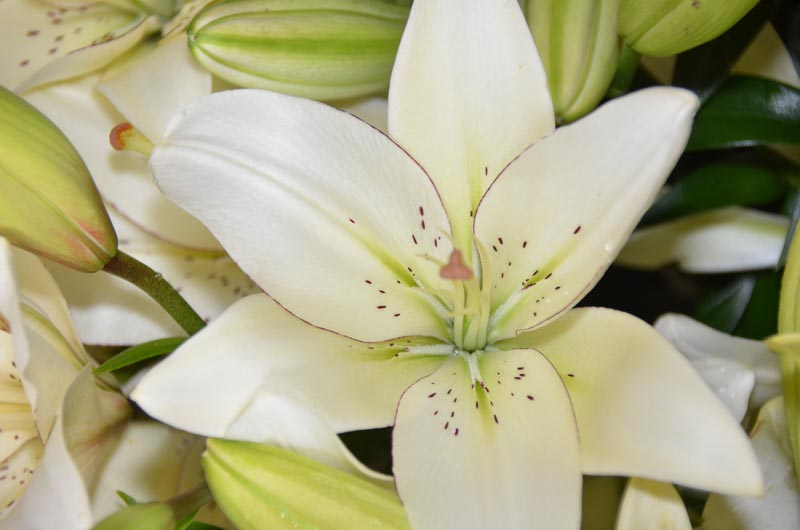Krishana Collins is sculpting bouquets in her flower studio. She wears knee-high, green rain boots and moves quickly down a row of three wooden tables standing end to end. Her face is set in a serious expression but she smiles easily, scrunching her nose and shaking her brown curls. She holds up a black knight scabiosa and looks down at the dark burgundy petals.
“This one is so beautiful,” she says.
Ms. Collins owns and operates Tea Lane Farm, a flower farm in Chilmark. “When we work on arrangements for weddings we see and experience the plants in the field,” she says. “We know the plants at every stage: seed, leaves, stem, in bud. We recognize all of the different levels of beauty. That is hard to teach unless you have the experience on the farm.”
For Ms. Collins the farm experience began with vegetables. She can trace her interest back to childhood when, at eight years old, she visited her grandfather who was a peanut farmer.
“My grandfather had planted corn, okra, all of these things, and there was a terrible drought that year. I filled a bucket and went around trying to water an acre of corn. That’s the interesting thing about people; you have to have a natural talent but also a natural interest.”
Ms. Collins began farming in Vermont at age 19. Growing up in Pensacola, Fla., she “only knew iceberg and romaine lettuce.” In Vermont her lettuce horizons widened. “I was introduced to 12 different varieties of lettuce that I had never tasted before in my life. Your taste buds just come alive. The same thing happens with flowers.”
At Tea Lane Farm, Ms. Collins opens the tailgate of her truck and begins unloading buckets of lilies. Dark “eyeliner” accents each petal of one variety while another boasts double blooms, a flower within a flower. The smell is sweet and rich.
“It’s funny,” Ms. Collins says. “We write on the buckets, ‘bridal flowers’ or ‘bridesmaid flowers,’ so that we can know what’s what when we are doing a wedding. We use the same buckets when we go to market and people have started asking for the ‘bridal variety’ of lilies.”
Ms. Collins grows about 30 varieties of sunflowers, 13 varieties of zinnias and hundreds of dahlias. She began growing flowers when her mother died. At the time Ms. Collins was working for Andrew Woodruff, another Island farmer. She felt the only thing that would make her feel better would be to grow a whole field of flowers.
“I didn’t care who bought them or if I would make any money, I just grew them,” she said. “This is just the most natural thing for me.”
Her office is a small room off an old barn on the farm. Inside she picks up a piece of paper from the top of a printer and holds it up. It is a picture of a bride holding a bouquet of pink and red flowers.
“Every wedding is different,” she says. “We listen to what the bride wants and brainstorm ideas. I always ask for a couple of adjectives and people answer with everything from ‘loose and wild’ to ‘symmetrical and monochromatic.’ Given the opportunity, brides will come walk in the fields, or they will work from images. I also ask them to send me pictures. This is amazing because I have a great number of people looking for great ideas. It helps me stay inspired.”
Outside the studio are a few buckets filled with flower pieces and damaged blooms. Another bucket holds flowing grasses. Ms. Collins touches the grasses, saying that a friend must have dropped them off for her to use. “For weddings we will use what we grow but we will also use whatever is blooming wild on the Island — wine berries, wild roses, wild clematis, wild sweet peas and grasses.”
Alisa Javits has worked for Ms. Collins for almost seven years. She said that weddings require a lot of late nights and a lot of coffee.
“There is lots of creativity when people trust us,” she said. “We go to every extreme and use local and wild plants on top of what we grow. In the fall we use apple branches and in the spring, dogwoods.”
Ms. Javits remembers a wedding last year where someone wanted a lush, packed garland hung over huge French doors overlooking the ocean. “It’s cool to have to try and design beautiful things,” she said.
The design process also motivates Ms. Collins. “It’s important to be uncomfortable, to challenge yourself creatively,” she says. “When I’m forced to come up with an idea it’s a pretty intense thought process. I love the ideas that come up in collaboration with others.”

Ms. Collins said that arbors are often created the day of the wedding. She listed other designs she has created: balls made of baby’s breath, dahlias hanging from a ceiling, fish tank table toppers filled with aquatic plants. “When someone gets married there’s an openness about them,” she says.
Ms. Collins heads out to one of her fields off State Road. A world of flowers rises taller than the farmer. Rows and rows of zinnias and sunflowers point to the sky. Two dogs lay in the space between the rows and three young women move quickly down the field.
“How’s it going?” Ms. Collins asks her crew.
“We just had some espresso and we’re speed-picking zinnias,” one of her workers answers. The women cut the zinnias and gather them into bunches for the farmers’ market.
“I’ve noticed brides that I did a wedding for coming to get flowers from me at the market,” Ms. Collins says. “Their husbands come to get flowers for an anniversary, or they’ll come to show me their children. It’s almost like I become a part of their family.”









Comments
Comment policy »